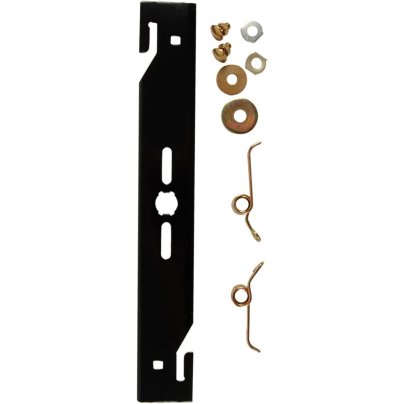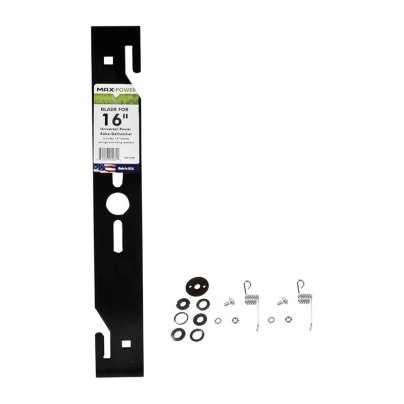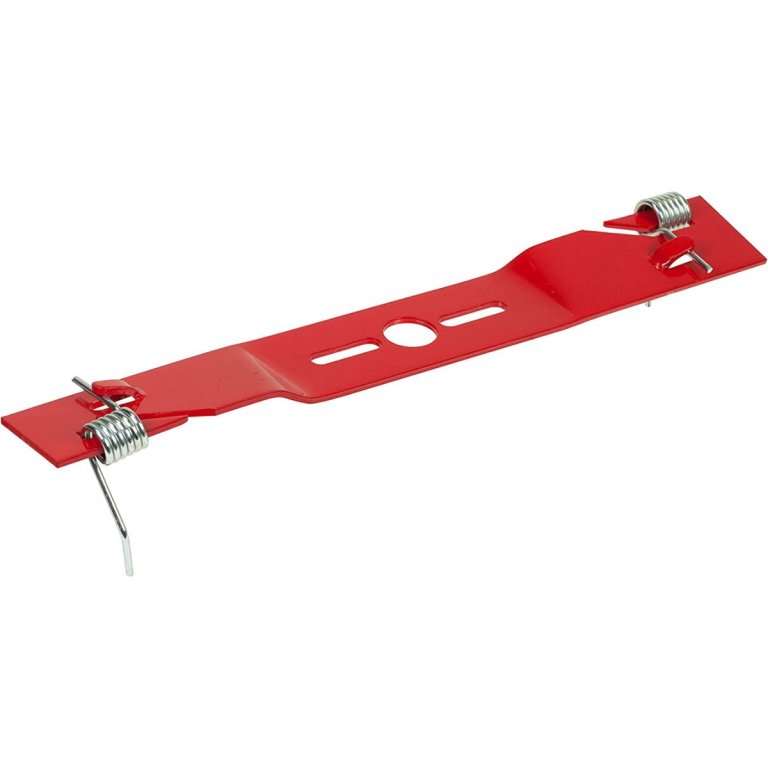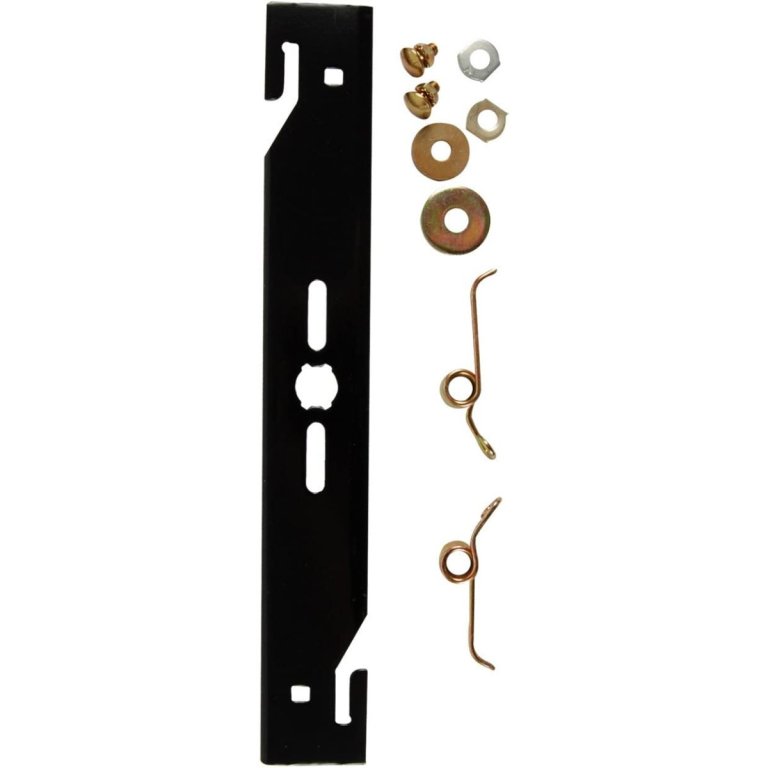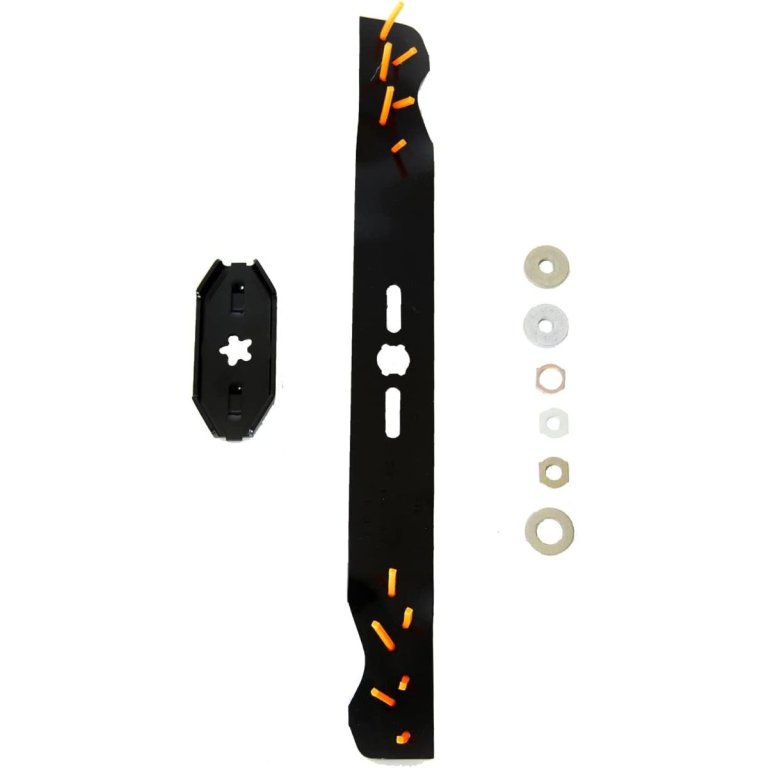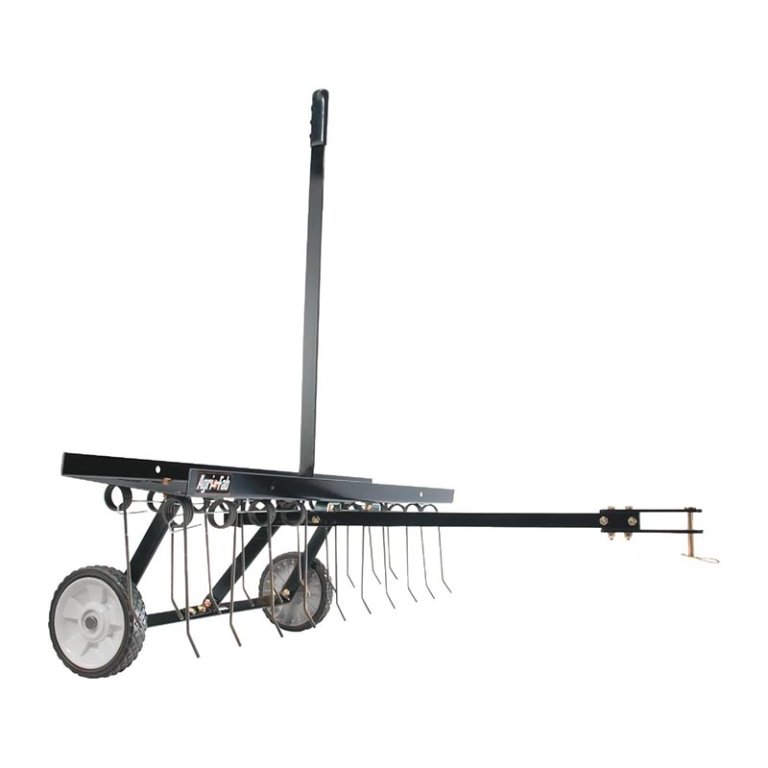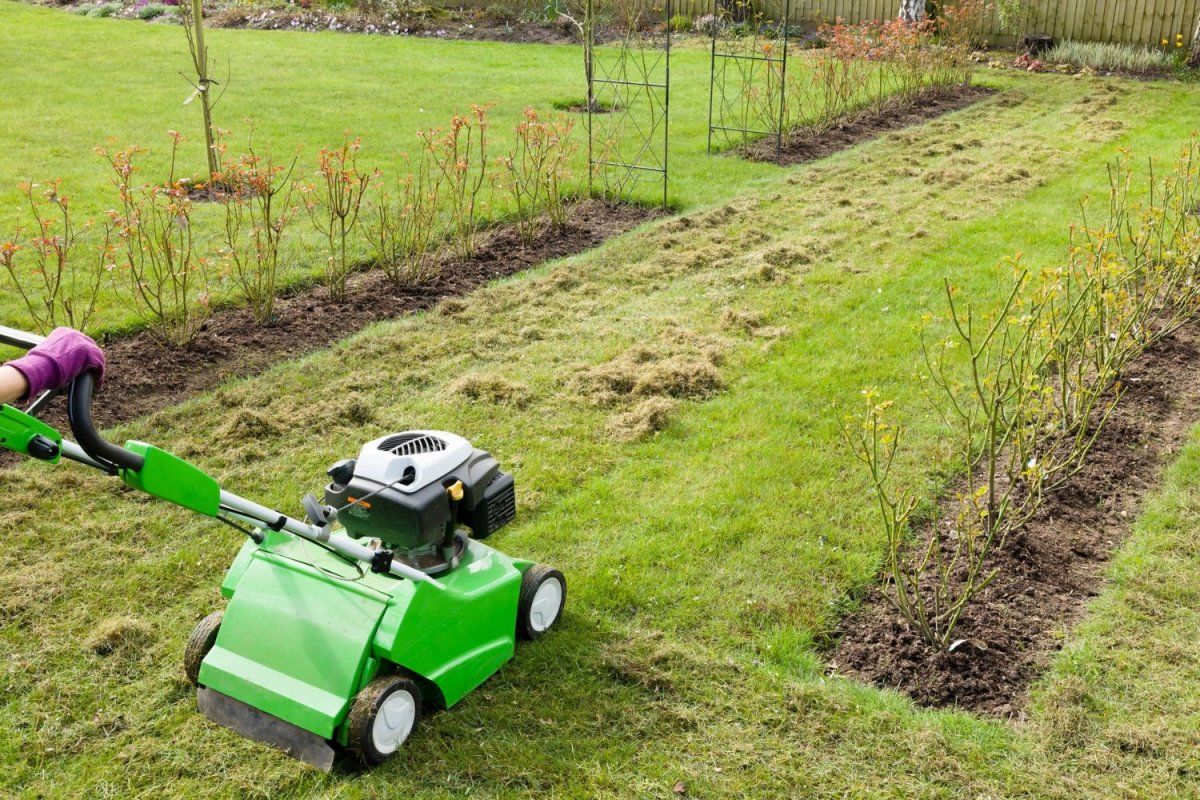
We may earn revenue from the products available on this page and participate in affiliate programs. Learn More ›
Dethatching blades offer an easy and affordable way to remove excess organic matter from your yard, helping your grass get the water and nutrients it needs. Though lawn clippings and dead leaves can act as natural fertilizer, if these materials build up faster than they can decompose, they should be manually removed.
Rather than renting or buying a standalone dethatcher to clear excess yard waste, you can simply attach a dethatching blade to your lawn mower. Lawn dethatcher blades resemble standard mower blades but have metal springs or plastic nylon trimmer lines that dig into the lawn, grab dead grass, and pull it out.
Still, if you’ve never used a lawn mower blade dethatcher, you likely don’t know how to choose one. To help, we researched dozens of options and reached out to a landscaping tool expert for advice. Based on our findings, we selected the Oregon 16″ Universal Dethatching Blade as our top pick for its effective performance and universal fit. Ahead, learn more about this and the rest of the specialty lawn mower attachments that made our list of the best dethatching blades.
- BEST OVERALL: Oregon 16″ Universal Dethatching Blade
↓ Jump to Review - BEST BANG FOR THE BUCK: Arnold 16″ Dethatching Blade
↓ Jump to Review - BEST FOR SMALL YARDS: MaxPower 16″ Universal Power Rake/Dethatcher
↓ Jump to Review - BEST FOR LARGE YARDS: Arnold Deluxe Universal Fit Dethatching Blade
↓ Jump to Review - BEST TOW-BEHIND: Agri-Fab 40″ Tow-Behind Tine Dethatcher
↓ Jump to Review
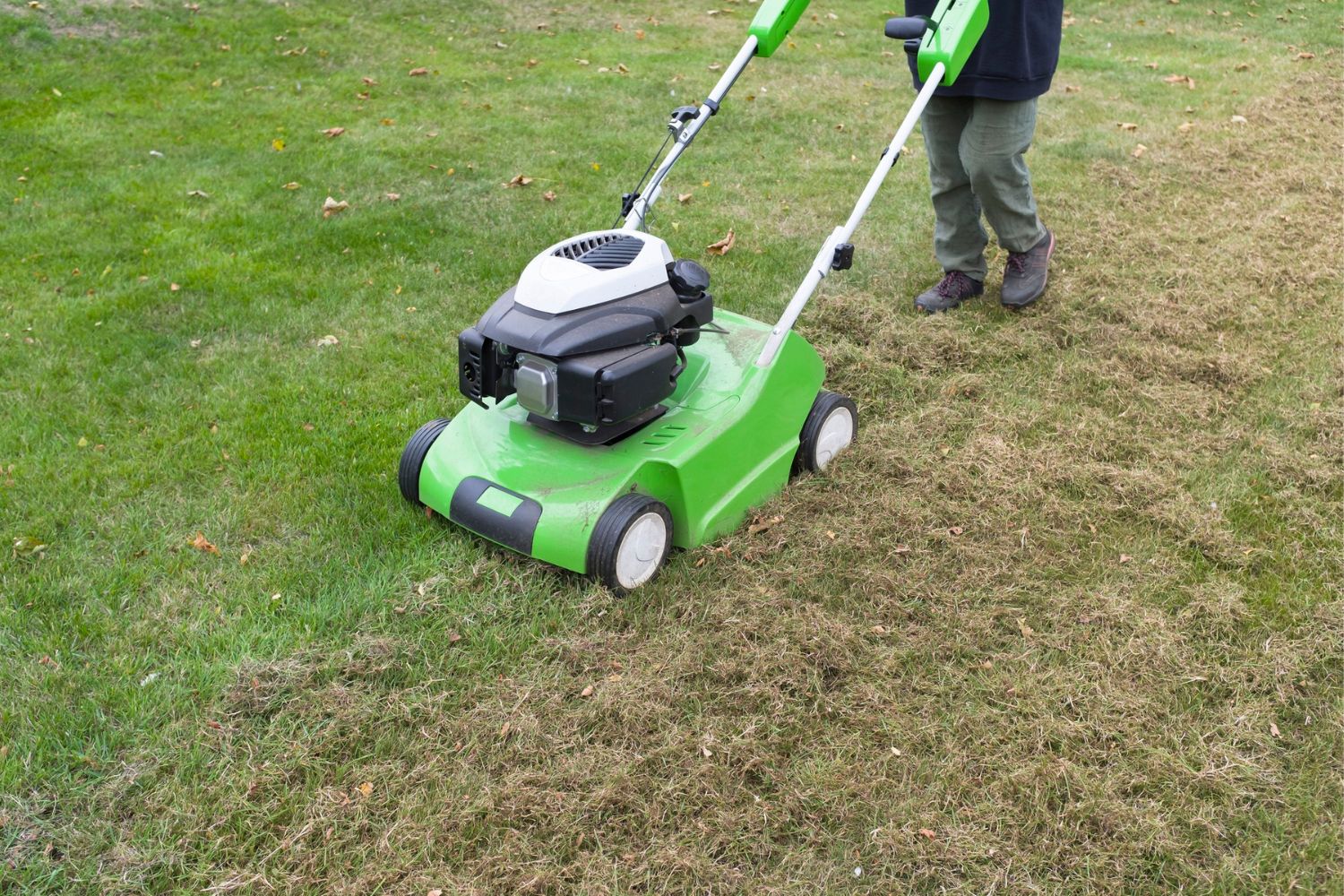
Dethatching Blades Comparison Chart
| Product Name | Length | Type | Compatibility |
| Oregon 16″ Universal Dethatching Blade | 16 inches | Metal springs | Universal |
| Arnold 16″ Dethatching Blade | 16 inches | Metal springs | Universal |
| MaxPower 16″ Universal Power Rake/Dethatcher | 16 inches | Metal springs | Universal |
| Arnold Deluxe Universal Fit Dethatching Blade | 21 inches | Nylon lines | Universal |
| Agri-Fab 40″ Tow-Behind Tine Dethatcher | 40 inches | Metal springs | Universal |
Our Top Picks
Each dethatching lawn mower attachment below is made with durable, heavy-gauge steel and a universal mounting design that’s compatible with most walk-behind and riding lawn mowers.
Best Overall
Oregon 16" Universal Dethatching Blade
What We Like
- Heavy-gauge metal construction
- Fits most lawn mowers
- Easy installation with included hardware
What We Don’t Like
- Leaves debris on lawn
Specs
- Length: 16 inches
- Type: Metal springs
- Compatibility: Universal
Durable construction, smart design, and universal compatibility make this dethatcher blade by Oregon a great choice for a broad range of push-mower brands. This 16-inch mower blade dethatcher is suitable for walk-behind mowers with decks up to 22 inches wide. Its spring metal blade does an excellent job of pulling up dead grass and even stubborn moss, making it ideal for dormant lawns with significant thatch buildup.
Thanks to an included assortment of washers and bolts, the universal design ensures compatibility with most mower brands. However, as with any thatching blade for a lawn mower, take care not to be too aggressive when using it to avoid damaging healthy grass. Also, be aware that the blade leaves most of the thatch sitting on top of the lawn rather than in the mower bag, so you may need to rake up excess debris.
Get the Oregon dethatching blade at Amazon or Walmart.
Best Bang for the Buck
Arnold 16" Dethatching Blade
What We Like
- Affordably priced
- Doubles as a standard mower blade
- Cuts and dethatches at the same time
What We Don’t Like
- Not compatible with decks over 22 inches
Specs
- Length: 16 inches
- Type: Metal springs
- Compatibility: Universal
At around half the cost of many other dethatching blades, this Arnold model is a great budget option for those who don’t want to spend a lot on a tool they may use only occasionally. Its metal spring tines are removable, allowing you to convert your machine from a dethatcher to a standard mower without detaching the blade. Also, since the blade has a sharp edge, you can cut and dethatch simultaneously.
This dethatch lawn mower blade comes with a variety of washers, nuts, and bolts, allowing it to fit most brands, including Craftsman, Troy-Bilt, and Ryobi. Its 16-inch size can handle small-to-medium-size yards and will fit mowing decks up to 22 inches.
Get the Arnold 16-inch dethatching blade at Amazon, Tractor Supply Co., Ace Hardware, The Home Depot, or Walmart.
Best for Small Yards
MaxPower 16" Universal Power Rake/Dethatcher
What We Like
- Includes various mounting hardware sizes
- Heavy-gauge steel construction
- Replaceable metal tines
What We Don’t Like
- Not ideal for large yards or dense thatch
Specs
- Length: 16 inches
- Type: Metal springs
- Compatibility: Universal
Though a power rake and a dethatcher have a few differences, they are sometimes referred to by the same name, as evidenced by this power rake/dethatcher blade from MaxPower. Like many other dethatching blades, it comes with hardware to fit many mower brands, though the range of included sizes is greater than that of most other options. Along with the blade itself, the kit contains six reducing washers between 3/16 of an inch to ⅝ of an inch, allowing it to adapt to a variety of mounting designs.
The dethatcher blade for a mower is made of heavy-gauge steel and includes two replaceable spring tines. Its 16-inch length makes it suitable for dethatching small-to-medium yards or large riding lawn mower decks that use two separate 16-inch blades.
Get the MaxPower dethatching blade at Amazon, Lowe’s, Tractor Supply Co., or The Home Depot.
Best for Large Yards
Arnold Deluxe Universal Fit Dethatching Blade
What We Like
- Ideal length for larger yards
- Mulches, cuts, and dethatches
- Gentler on healthy grass than metal spring blades
What We Don’t Like
- Not as effective as metal spring options
Specs
- Length: 21 inches
- Type: Nylon lines
- Compatibility: Universal
With its ability to cover more ground with each pass and nylon tines that are relatively easy on grass, this blade is ideal for larger lawns with light-to-moderate thatch buildup. At 21 inches long, it removes thatch more efficiently than shorter blades and fits mower decks up to 27 inches. It also cuts and mulches grass clippings, cutting down time spent on yard maintenance.
Although the blade’s six nylon lines aren’t as effective at removing dense thatch as blades with metal tines, they are gentler on the yard, causing less collateral damage to healthy grass. The blade has a universal fit and comes with hardware to suit most major lawn mower brands, including Toro, Huskee, Honda, Poulan Pro, Snapper, and Husqvarna.
Get the Arnold 21-inch dethatching blade at Amazon, Ace Hardware, or Blain’s Farm & Fleet.
Best Tow-behind
Agri-Fab 40" Tow-Behind Tine Dethatcher
What We Like
- Universal compatibility with garden tractors and riding mowers
- Works in 40-inch swaths
- Durable rust-proof and heat-treated tines
What We Don’t Like
- Leaves removed thatch on lawn
Specs
- Length: 40 inches
- Type: Metal springs
- Compatibility: Universal
This 40-inch riding mower dethatcher from Agri-Fab is a practical solution for garden tractor owners looking to dethatch large lawns quickly. With 20 rust-proof heat-treated tines, it loosens and lifts debris for better nutrient and water absorption. The transport handle makes it easy to raise and lower the metal springs easily without getting up off your seat.
Like each dethatching blade for push mowers on our list, this riding mower version features a universally compatible design that works with most brands. It has two 7-inch flat-free tires for smooth transport plus a 40-inch weight tray that holds up to 70 pounds for improved soil penetration. Just be careful not to add too much weight, as this can cause the tines to bend.
Get the Agri-Fab dethatching blade at Amazon, Lowe’s, Tractor Supply Co., Ace Hardware, or Walmart.
Jump to Our Top Picks
How We Chose the Best Dethatching Blades
A lawn dethatcher blade for a mower has a simple yet somewhat delicate job—picking dead grass out of the yard without damaging the existing lawn. To ensure effective yet gentle dethatching, we looked for blades with either metal springs or nylon tines that can remove debris without ripping up the yard.
The best dethatching blades must be durable, so we focused on models with heavy-gauge steel construction. Since mower compatibility is also important, we selected only universal blades designed to fit a wide range of popular brands, all of which include the mounting hardware necessary for easy installation. We were also careful to feature a few blades that cut while dethatching so you can minimize how much time you spend on lawn maintenance.
What to Consider When Choosing the Best Dethatching Blade
There are two types of dethatching blades: those with metal spring attachments and those that employ plastic nylon trimmer line. Understanding how they differ and which might be better for your lawn is integral to selecting the right one. To shop smarter, read on to learn more about these and other characteristics of these helpful landscaping and gardening tools.
Size
Blade size is crucial when selecting from among the best dethatching blades, as it determines whether or not it will fit the mowing deck and the width it can dethatch in a single pass. Most dethatching blades are between 16 and 21 inches long, and the one you select shouldn’t be longer than your cutting blade to ensure it doesn’t come into contact with the mowing deck. Though the blade can be smaller than the mower’s stock-cutting blade, it should not be more than 6 inches smaller than the size of the deck to ensure it functions properly.
Tine Type and Material
Dethatching blades consist of a steel lawn mower blade with metal spring tines or nylon plastic trimmer line.
The former consists of two removable metal springs—each with a pointy tine that juts outward—that attach to holes on opposite ends of the blade. As the blade spins, the two tines dig into the thatch, pulling it up and out of the soil. Nylon trimmer lines, in comparison, use the same type of line used with lawn trimmers to grab and lift thatch.
Metal spring dethatching blades are more durable and better able to remove dense thatch than blades that use nylon; however, metal tines have a tendency to pull out healthy clumps of grass along with thatch. Although blades that use nylon plastic trimmer line will do less damage to healthy grass than blades equipped with metal springs, they don’t last as long and aren’t as effective against thicker layers of thatch.
Compatibility
The best dethatching blades are designed to fit all the major lawn mower brands. The blades typically come with various hardware to suit a variety of blade-mounting designs. That said, it’s still important to check the manufacturer’s list of compatible lawn mower brands to ensure the blade fits the mower before purchase.
FAQs
If you’re wondering if your lawn needs dethatching or whether a tool like a dethatching rake would be better for your lawn, the following answers to commonly asked questions could help.
Dead grass clippings can build up over time, suffocating your lawn by preventing new grass seed and fertilizer from reaching the soil. Although it usually isn’t necessary to dethatch a lawn every year, it’s a good idea to do so every few years. If the thatch on your lawn is an inch or more deep, it needs dethatching.
It’s best to dethatch when the lawn is moist but not too wet. If the soil is too dry, even a sharp blade will struggle to remove the thatch. If the lawn is saturated, the dethatching blade is more likely to pull out clumps of healthy grass along with the dead grass clippings.
To get rid of thatch naturally, create conditions that will help it decompose. First, water regularly to ensure the soil underneath the layer of thatch remains moist. Second, when you mow, bag grass clippings to avoid adding to the problem until the thatch issue is under control. Finally, fertilize the lawn regularly with a product that contains nitrogen to speed up the decomposition process.
To dethatch your lawn with a lawn mower, purchase and install a dethatching blade. Once the blade is installed, set it to the proper height so that its tines remove the thatch without yanking out clumps of grass. It typically takes a little trial and error to find the proper height.
Yes, dethatching blades really work, though they are generally considered less effective for deep thatch or large areas than true dethatchers. If you have light-to-moderate thatch and a small-to-medium lawn, a dethatching blade could be an excellent choice.
The best depth for dethatching is generally between about ¼ inch and ½ inch into the soil. This is deep enough to remove excess material without digging into the roots.
Since aerating and dethatching address different issues, the one that’s better depends on your lawn’s specific condition and needs. Dethatching is best if your grass has an excessive buildup of organic matter that’s blocking water and nutrients from reaching the roots, and aerating is ideal if the soil itself is overly compact.
We reached out to Jeff Taylor, Manager of Product Services for STIHL Inc., for help with this question. According to Jeff, “It’s best to mow your lawn before dethatching. Longer grass can cause the tines on a dethatcher to get caught, so mowing first ensures a clean lawn and allows the dethatching tool to reach the thatch layer without damaging healthy grass blades.”
STIHL’s Jeff Taylor also provided insight into this issue, stating, “It’s important to remove the thatch from your lawn to allow water and nutrients to penetrate the soil effectively.”

